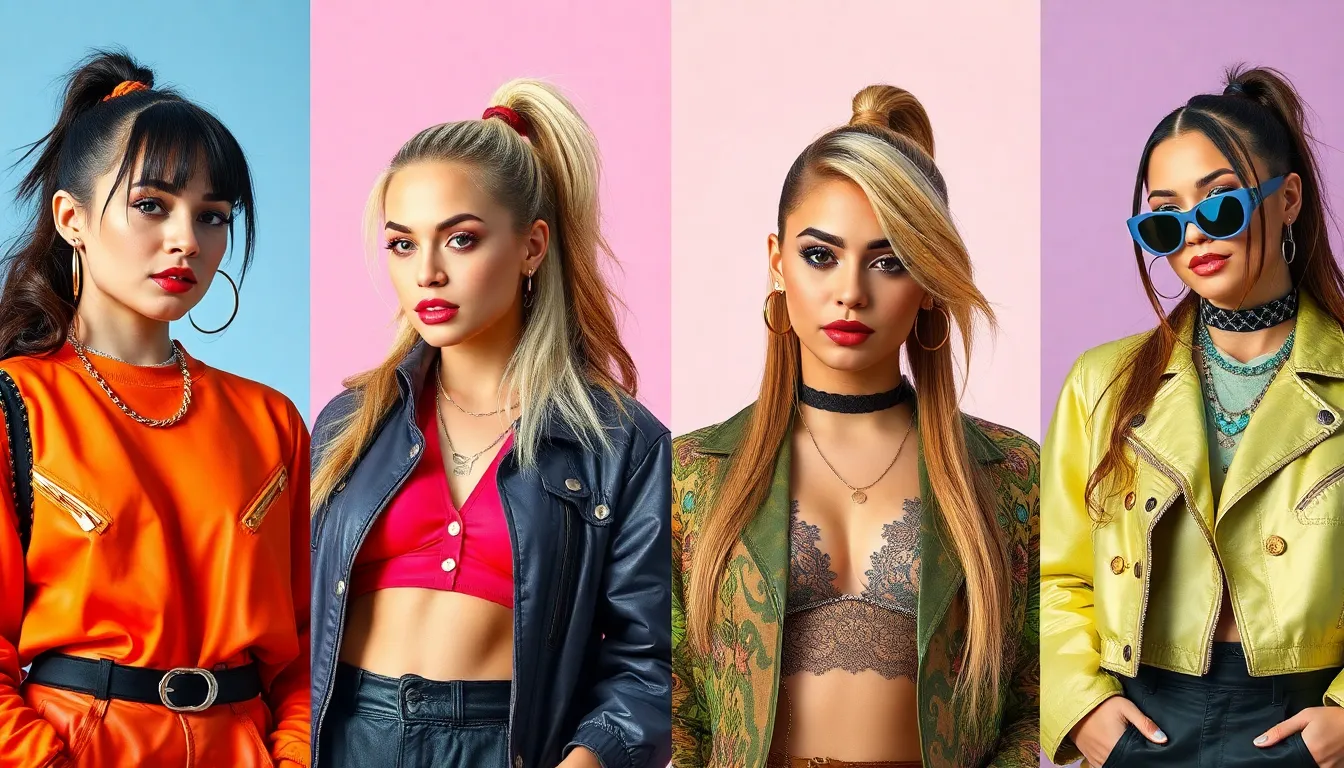The female mullet is making a fierce comeback and we’re absolutely here for it. Once dismissed as a hairstyle of the past this bold cut has transformed into one of today’s most sought-after looks combining edgy rebellion with feminine flair. From celebrities to everyday trendsetters women everywhere are embracing the “business in front party in the back” philosophy with stunning modern twists.
We’ve watched this iconic style evolve from its 80s roots into something completely fresh and versatile. Today’s female mullets aren’t just about length contrast – they’re about self-expression confidence and breaking traditional beauty boundaries. Whether you’re considering a subtle shag-inspired version or going full rockstar with dramatic layers this cut offers endless possibilities for customization.
Ready to discover why the female mullet has captured the hearts of style mavens worldwide? We’ll explore everything from celebrity inspiration to maintenance tips helping you decide if this daring look deserves a spot in your hair evolution.
What Is a Female Mullet and Why Is It Trending Again?
Female mullet styles have evolved far beyond their 80s reputation, emerging as one of today’s most versatile and expressive hairstyles. This contemporary renaissance reflects our collective desire for authenticity and bold self expression.
Definition of the Modern Female Mullet
Today’s female mullet represents a sophisticated interpretation of the classic “business in the front, party in the back” concept. We’re seeing hairstylists create versions that blend shorter layers around the face with dramatically longer sections at the nape. Modern variations include subtle graduated lengths that create seamless transitions rather than harsh contrasts.
Contemporary mullets incorporate texturizing techniques, layered cutting methods, and personalized styling approaches that weren’t available during the original trend. These updates allow for customization based on face shapes, hair textures, and individual preferences. Professional stylists now use razor cutting and point cutting to create softer edges and more natural movement.
Key Characteristics That Define the Style
Length variation serves as the mullet’s most defining feature, with front sections typically measuring 2 to 4 inches while back lengths extend 6 to 12 inches beyond the neckline. Layering creates the essential shape, starting with shorter crown pieces that gradually increase in length toward the back. Side sections often feature medium lengths that bridge the gap between front and back portions.
Texture plays a crucial role in modern mullet execution, with many stylists incorporating choppy layers, razored ends, or subtle waves to enhance the overall effect. Face framing elements include wispy bangs, curtain bangs, or side swept sections that soften harsh lines. Volume distribution varies based on styling preferences, with some versions emphasizing lifted crowns while others focus on dramatic back sections.
Styling versatility allows wearers to adjust their look from professional to edgy using different products and techniques. We’ve observed that successful mullets maintain balance between contrasting lengths while ensuring the overall shape complements the wearer’s features and lifestyle needs.
10 Stunning Female Mullet Variations to Consider

These modern mullet interpretations showcase how versatile this trending hairstyle can be for different face shapes and personal styles.
The Classic Shag Mullet
Classic shag mullets combine the traditional mullet structure with feathered layers throughout the hair. We recommend this style for women seeking a vintage inspired look that frames the face beautifully with shorter front pieces measuring 3 to 5 inches. The back section typically extends 8 to 10 inches with heavy texturizing to create movement and bounce.
Styling requires volumizing mousse applied to damp hair before blow drying with a round brush. The shag elements soften harsh mullet lines while maintaining the signature length contrast. This variation works exceptionally well for fine to medium hair textures.
The Curly Female Mullet
Curly mullets enhance natural texture while embracing the mullet’s rebellious spirit. We’ve observed that curl patterns from 2A to 4C benefit from this cut when properly executed with moisture rich products. The shorter crown areas measure 2 to 4 inches while curly back sections can extend up to 12 inches.
Defining cream and leave in conditioner become essential styling products for maintaining curl definition. The natural volume of curly hair eliminates the need for additional texturizing techniques. This style particularly flatters oval and heart shaped faces.
The Asymmetrical Mullet Cut
Asymmetrical mullets feature intentionally uneven lengths that create visual interest and modern edge. We position one side shorter than the other, typically with a 2 to 3 inch difference in length around the ears. The back maintains traditional mullet proportions with dramatic length variation.
Creating this look requires precision cutting techniques and regular maintenance every 6 to 8 weeks. The asymmetry draws attention to facial features while the mullet structure maintains the style’s characteristic boldness. This variation suits confident individuals ready to make a statement.
The Pixie Mullet Hybrid
Pixie mullets merge ultra short front sections with longer back pieces for maximum contrast. We cut the top and sides to traditional pixie length (1 to 2 inches) while preserving 4 to 8 inches of length at the nape. This creates a dramatic silhouette that’s both edgy and feminine.
Maintenance involves frequent touch ups every 4 to 6 weeks to preserve the clean pixie elements. The styling process takes minimal time with texturizing paste worked through the longer back sections. This hybrid works best for women with strong facial features and confident personalities.
The Wolf Cut Mullet
Wolf cuts incorporate shaggy layers throughout while maintaining mullet proportions for a wild, untamed appearance. We layer the entire head with choppy cuts that blend the shorter front (3 to 4 inches) into the longer back (6 to 10 inches). The result resembles a modern interpretation of 70s rock star hair.
Air drying with sea salt spray enhances the natural texture and creates the desired messy finish. The layering technique works particularly well for thick, coarse hair types that can support heavy texturizing. This style requires minimal daily styling but benefits from professional cuts every 8 to 10 weeks.
The Layered Textured Mullet
Layered textured mullets feature extensive layering throughout all sections for maximum movement and dimension. We cut multiple layer lengths from 2 inches at the crown to 10 inches at the nape, creating a cascading effect. Point cutting techniques add texture without removing too much bulk.
Texturizing spray applied to damp hair before scrunching creates the desired piece separation. The multiple layer lengths ensure the style maintains shape as it grows out between appointments. This variation flatters most face shapes and hair textures.
The Edgy Punk Mullet
Edgy punk mullets embrace the style’s rebellious roots with sharp angles and dramatic contrasts. We create severe disconnection between the short sides (buzzed to 1/2 inch) and long back sections (8 to 12 inches). Razor cutting techniques enhance the aggressive aesthetic.
Strong hold gel slicks down the shorter sections while the longer pieces can be spiked or left loose. This high maintenance style requires touch ups every 3 to 4 weeks to maintain sharp lines. The punk mullet suits individuals in creative fields or those embracing alternative fashion.
The Soft Feminine Mullet
Soft feminine mullets incorporate gentle layering and face framing pieces for a romantic interpretation. We blend shorter front sections (4 to 6 inches) gradually into longer back pieces (8 to 10 inches) using point cutting for softness. Wispy bangs and side swept pieces create flattering face framing.
Blow drying with a paddle brush creates smooth, polished results while maintaining the mullet silhouette. This version works well in professional environments while still embracing the trendy mullet structure. Regular deep conditioning treatments maintain the health of longer back sections.
The Bold Colored Mullet
Bold colored mullets use vibrant hues to emphasize the style’s dramatic structure and length contrasts. We recommend contrasting colors between sections, such as platinum blonde fronts with jewel toned backs. The color placement enhances the natural mullet proportions while adding visual impact.
Professional coloring every 6 to 8 weeks maintains vibrancy while color safe shampoos protect the investment. Temporary options like colored chalk or spray provide commitment free experimentation. This variation requires healthy hair as a foundation due to the chemical processing involved.
The Vintage Inspired Mullet
Vintage inspired mullets recreate classic 80s proportions with modern cutting techniques for contemporary wearability. We maintain traditional ratios with shorter crowns (2 to 3 inches) and dramatic back length (10 to 14 inches). Feathering techniques soften harsh lines while preserving authentic proportions.
Hot rollers or crimping irons recreate period appropriate texture and volume. This nostalgic interpretation appeals to those embracing retro fashion trends while maintaining current hair health standards. Regular protein treatments strengthen longer sections prone to damage.
How to Choose the Right Female Mullet for Your Face Shape

Selecting the perfect mullet involves understanding your unique facial structure and proportions. We’ll guide you through customized recommendations that enhance your best features while creating a flattering silhouette.
Round Face Shape Considerations
Create vertical lines with a high-contrast mullet that features shorter front layers measuring 2 to 3 inches and dramatically longer back sections extending 8 to 12 inches. Sharp, choppy texturizing techniques work best to add angular definition around your jawline and cheekbones.
Avoid blunt cuts across your forehead, as these emphasize facial width rather than creating length. Instead, opt for wispy, side-swept bangs that graze your eyebrows at an angle. The classic shag mullet and asymmetrical mullet cut work exceptionally well for round faces.
Position your longest layers below your chin to draw attention downward and create the illusion of length. We recommend incorporating subtle layering throughout the crown area to add height and volume at the top of your head.
Square Face Shape Guidelines
Soften sharp jawlines with gentle, rounded layers that curve naturally around your face rather than creating harsh geometric lines. The soft feminine mullet and curly female mullet variations work beautifully to counterbalance angular features.
Focus on adding width at your temples and around your ears through voluminous side layers that measure 3 to 5 inches in length. Texturized cutting techniques create movement that breaks up the strong horizontal lines of your jaw and forehead.
Incorporate face-framing pieces that start at your cheekbones and gradually lengthen toward your neckline. We suggest avoiding extremely short pixie mullet hybrids, as these can emphasize the squareness of your facial structure.
Oval Face Shape Options
Experiment freely with virtually any mullet variation, as your balanced proportions accommodate both dramatic and subtle interpretations. The wolf cut mullet, layered textured mullet, and edgy punk mullet all complement oval face shapes exceptionally well.
Play with proportions by adjusting the contrast between your front and back lengths based on your personal style preferences. You can successfully wear front sections as short as 1.5 inches or as long as 4 inches while maintaining facial harmony.
Consider your lifestyle when choosing between maintenance-heavy options like the bold colored mullet or lower-maintenance styles such as the vintage inspired mullet. Your versatile face shape allows you to prioritize personal preference over structural limitations.
Heart-Shaped Face Recommendations
Balance your wider forehead with fuller, textured layers that begin at your jawline and extend to your shoulders. The layered textured mullet and soft feminine mullet create visual weight at the bottom of your face to counteract top-heaviness.
Minimize volume at your crown and temples while maximizing texture and movement around your chin and neck area. We recommend keeping front layers between 3 to 4 inches to avoid overwhelming your delicate jawline.
Choose side-parted styles that create asymmetrical interest while drawing attention away from your broader forehead area. Avoid center parts and blunt bangs that emphasize the width of your upper face and make your chin appear even more pointed.
Styling Tips for Maintaining Your Female Mullet

Proper styling techniques ensure your female mullet maintains its distinctive shape and rebellious charm day after day. We’ve compiled essential maintenance strategies that keep your cut looking fresh and professionally styled.
Daily Styling Techniques
Start with damp hair and work a volumizing mousse through your roots for maximum lift in the front sections. Apply the product using upward scrunching motions to enhance your mullet’s natural texture and movement.
Use a wide tooth comb to gently detangle your hair from ends to roots, preventing breakage in the longer back sections. Work through knots slowly to maintain the integrity of your layered cut.
Scrunch your hair with a microfiber towel to remove excess moisture without creating frizz. This technique preserves your mullet’s natural texture while reducing drying time significantly.
Flip your head upside down while blow drying to create volume at the crown and enhance the contrast between your front and back lengths. Focus the airflow on your roots for the first 2 to 3 minutes.
Separate your sections using your fingers rather than a brush to maintain the choppy, textured appearance that defines modern mullets. This finger styling technique creates natural separation and movement.
Sleep with a silk pillowcase to reduce friction and maintain your style overnight. The smooth surface prevents your mullet from developing flat spots or unwanted cowlicks while you rest.
Products That Work Best
Texturizing spray becomes your mullet’s best friend, creating the tousled, lived in look that makes this cut so appealing. Apply it to damp hair before styling and again as a finishing touch.
Sea salt spray enhances your hair’s natural wave pattern and adds the gritty texture that mullets require. We recommend using products with 2 to 3 percent salt concentration for optimal results.
Lightweight hair oil smooths the longer back sections without weighing them down, preventing the stringy appearance that can plague poorly maintained mullets. Apply just 2 to 3 drops to mid lengths and ends.
Volumizing powder at the roots creates lift and separation in the shorter front layers. Sprinkle it directly onto clean, dry scalp and massage it through for instant body and texture.
Flexible hold hairspray locks in your style without creating stiffness or crunch. Look for products labeled as “workable” or “brushable” to maintain your mullet’s natural movement.
Leave in conditioner protects your hair from environmental damage while maintaining moisture balance between your varying lengths. Apply it primarily to the longer sections that experience more wear.
Heat Styling Do’s and Don’ts
Do use a heat protectant on every section before applying any heated tools to prevent damage and maintain your cut’s health. Apply the product when your hair is 80 percent dry for maximum effectiveness.
Don’t exceed 300 degrees Fahrenheit when using styling tools on your mullet, as higher temperatures can damage the delicate layered sections. Most hair types achieve excellent results at temperatures between 250 to 280 degrees.
Do focus heat styling on the front sections where you want sleekness and control, while allowing the back to air dry for natural texture. This approach creates the perfect contrast that defines a well styled mullet.
Don’t curl the entire length of your longer back sections, as this can eliminate the edgy, undone quality that makes mullets so distinctive. Instead, curl only the bottom 2 to 3 inches for subtle movement.
Do use a diffuser attachment when blow drying curly or wavy mullets to maintain your natural texture while reducing frizz. Keep the heat setting on low and the speed on medium for best results.
Don’t straighten your mullet completely flat, as this removes the dimension and movement that make the cut interesting. Leave some natural texture and bend in both the front and back sections.
Celebrities Who Rock the Female Mullet Look

Celebrity endorsements have transformed the female mullet from an underground style into mainstream fashion. We’ve witnessed many stars embrace this bold haircut, inspiring millions to experiment with their own mullet transformations.
Music Industry Icons
Billie Eilish pioneered the modern female mullet movement with her signature green and black variation in 2019. She styled her mullet with choppy layers measuring 3 inches in front and 8 inches in back, creating dramatic contrast that perfectly matched her alternative aesthetic.
Miley Cyrus transformed her image multiple times with various mullet interpretations since 2012. Her most iconic version featured platinum blonde coloring with textured layers that measured 2.5 inches around her face and extended 10 inches down her neck.
Dua Lipa experimented with a sleek mullet during her “Future Nostalgia” era, incorporating subtle layering techniques. She maintained 4 inch front sections while allowing her back layers to cascade 7 inches, creating a sophisticated take on the classic cut.
Yungblud consistently rocks colorful mullets that blend punk aesthetics with contemporary styling. His influence has encouraged female fans to adopt similar bold approaches, featuring bright colors and dramatic length variations.
Hollywood Actresses
Zendaya showcased multiple mullet variations on red carpets and in casual settings throughout 2021. She demonstrated versatility by styling her cut with both sleek finishes and tousled textures, proving the mullet’s adaptability for formal events.
Scarlett Johansson embraced a refined mullet for several movie premieres, featuring subtle layering that measured 3.5 inches in front. Her styling choices highlighted how the cut can enhance facial features while maintaining professional elegance.
Kristen Stewart adopted an edgy mullet that perfectly complemented her rebellious persona during her “Charlie’s Angels” promotion period. She kept her front layers at 2 inches while extending back sections to 9 inches for maximum impact.
Cate Blanchett surprised fans with a sophisticated mullet interpretation that challenged age related hair conventions. Her version featured gentle layering and neutral tones that proved the style’s versatility across different demographics.
Social Media Influencers
Emma Chamberlain popularized the “soft mullet” trend among Gen Z followers through her YouTube channel and Instagram posts. She documented her mullet journey from initial cut to styling tutorials, generating over 2 million views across platforms.
Bretman Rock influenced both male and female audiences with his colorful mullet transformations, featuring rainbow highlights and creative styling techniques. His tutorials consistently receive 500,000+ views, demonstrating important audience engagement.
Nikocado Perry transformed his image with a dramatic mullet makeover that sparked conversation across TikTok and Instagram. His before and after posts accumulated 1.5 million likes, inspiring followers to share their own mullet transformations.
James Charles experimented with temporary mullet styles using clip in extensions and creative cutting techniques. His mullet related content reaches audiences of 15+ million followers, significantly expanding the style’s visibility among younger demographics.
Professional Considerations for Female Mullet Hairstyles

Handling professional environments with a female mullet requires strategic styling that maintains the cut’s edgy appeal while meeting workplace standards. We’ve found that proper preparation and technique can transform your mullet into a polished, career-appropriate look.
Workplace-Appropriate Styling
Sleek front sections create an instantly professional appearance by using a small amount of smoothing serum on the hair around your face. We recommend blow-drying the front layers straight down with a paddle brush to minimize the dramatic length contrast. Tucking techniques work exceptionally well for conservative office environments, where you can tuck the longer back sections under and secure them with bobby pins that match your hair color.
Low maintenance updos offer versatility throughout your workday by pulling the longer sections into a small bun at the nape. We suggest leaving the shorter front pieces loose and styled forward to frame your face naturally. Braided back sections provide another professional option, where you can create small braids with the longer pieces and pin them up discretely.
Product selection plays a crucial role in maintaining workplace appropriateness with pomades and gels offering stronger hold for structured looks. We find that matte finish products work better than glossy ones in conservative settings, as they provide control without appearing overly styled. Heat styling tools like flat irons can temporarily tone down the mullet’s rebellious nature by smoothing both the front and back sections into a more uniform length appearance.
Interview-Ready Versions
Conservative styling approaches focus on minimizing the length contrast between front and back sections through careful positioning and product use. We recommend applying a strong-hold gel to the longer back pieces and combing them forward over your shoulders, creating the illusion of a more traditional layered cut. Professional accessories like headbands or small hair clips can help control flyaway pieces while maintaining a polished appearance.
Temporary transformation techniques allow you to modify your mullet for important meetings without permanent changes to the cut. We suggest using hair wax to piece out the shorter sections and create a more structured, business-like silhouette. Blow-drying methods become essential for interview preparation, where you’ll want to dry the back sections forward and under to reduce their apparent length.
Color considerations matter significantly in professional settings, where natural tones like deep browns, blacks, and subtle highlights typically receive better reception than bold colors. We find that scheduling color touch-ups before important career events helps maintain a fresh, professional appearance. Styling time management requires planning, as interview-ready mullet styling typically takes 15 to 20 minutes longer than casual everyday looks.
How to Ask Your Stylist for the Perfect Female Mullet

Getting the female mullet of your dreams starts with clear communication. Mastering the consultation process ensures you’ll walk out with a cut that matches your vision perfectly.
Essential Communication Tips
Describing your desired mullet length becomes crucial when communicating with your stylist. We recommend using exact measurements rather than vague terms like “short” or “long” to avoid misunderstandings. Front layers should measure between 2 to 4 inches for most face shapes, while back sections typically extend 6 to 12 inches depending on your preference.
Texture preferences need detailed explanation during your consultation. Choppy layers create an edgier appearance, while soft layers provide a more feminine touch. Wispy bangs can complement the overall look, so discuss whether you want face-framing pieces or prefer a cleaner hairline.
Lifestyle factors should guide your mullet conversation with your stylist. Busy professionals might prefer low-maintenance versions that require minimal daily styling. Active individuals need cuts that maintain their shape through workouts and frequent washing.
Hair type considerations directly impact your mullet’s final appearance. Fine hair benefits from shorter back lengths to avoid looking stringy, while thick hair can handle longer, more dramatic ratios. Curly textures require different cutting techniques than straight hair to achieve the desired mullet proportions.
Maintenance commitment deserves honest discussion before making the cut. Most female mullets need trimming every 4 to 6 weeks to maintain their shape. We suggest asking about touch-up frequency and styling time requirements upfront.
Reference Photos to Bring
Multiple angle shots provide your stylist with comprehensive visual guidance for your mullet transformation. Front-facing photos show the desired face-framing layers, while side profiles reveal the length contrast you’re seeking. Back views demonstrate the exact tapering and layering techniques needed.
Celebrity inspiration images help establish your mullet’s overall vibe and styling direction. Billie Eilish’s bold colored mullets showcase dramatic contrast, while Miley Cyrus’s textured versions offer softer transitions. Save at least three different celebrity examples to give your stylist options.
Lifestyle-appropriate examples ensure your chosen mullet fits your daily routine and professional environment. Workplace-friendly versions feature subtler length differences and polished styling. Weekend-casual mullets can embrace more dramatic proportions and edgier texturing.
Color coordination photos become essential if you’re planning to combine your mullet with new hair color. Balayage highlights can enhance the layered texture, while bold fashion colors create striking contrast. Bring examples that show both the cut and color working together harmoniously.
Texture reference images clarify the exact styling finish you want to achieve regularly. Sleek, straight mullets require different cutting techniques than tousled, beachy versions. Curly mullet photos help your stylist understand how to work with your natural texture patterns.
Maintenance Schedule for Female Mullet Cuts

Proper maintenance keeps your female mullet looking fresh and styled between salon visits. We’ve outlined essential scheduling guidelines to help you maintain the perfect balance of texture and length that makes this hairstyle so distinctive.
Recommended Trim Frequency
Every 4 to 6 weeks represents the optimal trim schedule for maintaining your female mullet’s shape and preventing split ends from traveling up the hair shaft. Professional stylists recommend booking appointments within this timeframe to preserve the distinct length contrast that defines the mullet aesthetic.
Front sections require more frequent attention since they frame your face and grow out faster than back layers. We suggest trimming the shorter front pieces every 3 to 4 weeks to maintain their structured appearance and prevent them from losing their intended shape.
Back sections need less frequent maintenance due to their longer length and layered cutting technique. Trimming every 6 to 8 weeks keeps the back flowing naturally while removing any damaged ends that could compromise the overall look.
Textured mullets demand consistent upkeep because their choppy layers and wispy elements can quickly lose definition as they grow. Schedule appointments every 4 weeks to maintain the intentional unevenness that creates visual interest.
Color touch ups should coincide with trims when you’re sporting a bold colored mullet variation. Plan for color refresh appointments every 6 to 8 weeks to prevent fading and maintain vibrant tones that complement your cut’s edgy aesthetic.
At-Home Care Routines
Weekly deep conditioning treatments restore moisture to your mullet’s varying lengths and textures using protein rich masks or leave in treatments. Apply conditioner from mid length to ends, focusing extra attention on the longer back sections that experience more environmental damage.
Daily styling involves minimal product application to enhance your mullet’s natural texture without weighing down the shorter front layers. Use a dime sized amount of texturizing cream on damp hair, scrunching from roots to tips to encourage movement and definition.
Gentle detangling prevents breakage when you work through knots using a wide tooth comb or wet brush starting from the ends and moving upward. Never brush wet mullet hair aggressively, as this can disrupt the intentional texture and create unwanted frizz.
Overnight protection maintains your mullet’s shape through silk pillowcases or satin scarves that reduce friction while you sleep. Loosely braid longer back sections or use a silk scrunchie to prevent tangling without creating dents in your hair.
Weekly scalp massages stimulate healthy growth using lightweight oils like jojoba or argan oil applied directly to your scalp in circular motions. Focus on areas where shorter layers meet longer sections to promote even growth patterns throughout your mullet.
Common Mistakes to Avoid with Female Mullets

Even the most stylish female mullets can lose their edge when common pitfalls derail your look. We’ve identified the most frequent errors that prevent mullets from reaching their full potential.
Styling Errors
Over-brushing the back sections ruins the textured appearance that defines modern female mullets. We recommend using fingers or wide-tooth combs to separate layers naturally instead of traditional brushes that create unwanted smoothness. Daily brushing eliminates the choppy texture that makes mullets distinctive and edgy.
Applying too much product weighs down the layers and creates a greasy appearance that contradicts the mullet’s free-spirited aesthetic. Start with pea-sized amounts of texturizing cream or sea salt spray before adding more product. Heavy application particularly affects fine hair types, making them appear flat and lifeless.
Ignoring the front-to-back ratio creates an unbalanced look that loses the classic mullet proportions. Keep front layers between 2 to 4 inches while maintaining 6 to 12 inches in the back sections. Equal lengths throughout eliminate the signature contrast that defines authentic mullet styling.
Using the wrong heat settings damages the delicate layered structure that gives mullets their shape. Set blow dryers to medium heat and flat irons to 300°F or lower to preserve hair health. Excessive heat particularly affects the shorter front pieces, causing breakage and uneven growth patterns.
Neglecting face-framing layers makes the mullet appear disconnected from your facial features. Style these pieces with slight bends or waves to create seamless transitions between sections. Straight, blunt front layers often clash with the textured back portions of contemporary mullet cuts.
Maintenance Mishaps
Waiting too long between trims allows the mullet’s shape to grow out and lose its distinctive silhouette. Schedule appointments every 4 to 6 weeks to maintain proper proportions and prevent split ends from traveling up the hair shaft. Extended periods between cuts particularly affect the front sections that grow faster than back layers.
Washing too frequently strips natural oils that keep textured mullets looking healthy and defined. Limit shampooing to 2 to 3 times per week, using dry shampoo on off days to maintain freshness. Daily washing especially damages color-treated mullets, causing premature fading and dryness.
Skipping deep conditioning treatments leaves layered mullets prone to tangles and breakage throughout the different length sections. Apply weekly protein masks to strengthen damaged areas and moisture treatments for hydration. Neglected conditioning particularly affects the longest back sections that experience the most environmental damage.
Sleeping without protection causes morning tangles that require aggressive detangling and damage the mullet’s layered structure. Use silk pillowcases or satin scarves to reduce friction while you sleep. Unprotected sleeping habits particularly affect curly and wavy mullets, creating frizz and disrupting natural curl patterns.
Attempting DIY trims often results in uneven layers that destroy the mullet’s carefully crafted proportions. Leave cutting to professional stylists who understand the technical requirements for maintaining proper angles. Self-trimming mistakes particularly damage the back sections where visibility is limited during at-home cutting attempts.
Conclusion
The female mullet represents more than just a hairstyle trend—it’s a powerful statement of personal freedom and creative expression. We’ve seen how this versatile cut adapts to different face shapes lifestyles and professional environments while maintaining its distinctive edge.
Success with your mullet journey depends on choosing the right variation for your features and committing to proper maintenance. Remember that regular trims professional consultations and quality styling products are essential investments in keeping your mullet looking its best.
Whether you’re drawn to the subtle sophistication of a soft feminine mullet or the bold statement of a punk-inspired variation this hairstyle offers endless possibilities for self-expression. The key lies in finding the perfect balance between your personal style and practical considerations.
Frequently Asked Questions
What is a female mullet hairstyle?
A female mullet is a modern interpretation of the classic “business in front, party in the back” hairstyle. It features shorter layers around the face (2-4 inches) and longer sections at the nape (6-12 inches), creating a versatile look that combines edgy rebellion with feminine flair through texturizing techniques and layered cutting methods.
How often should I trim my female mullet?
You should trim your female mullet every 4 to 6 weeks to maintain its shape and prevent split ends. The front sections may need more frequent trims than the back. Regular maintenance is essential to preserve the mullet’s distinctive silhouette and keep it looking fresh and stylish.
What face shapes work best with female mullets?
Female mullets work for all face shapes with proper customization. Round faces benefit from high-contrast mullets with shorter front layers, square faces need softer rounded layers, oval faces can experiment with various styles, and heart-shaped faces should focus on textured layers to balance proportions.
How do I style a female mullet for work?
To make your female mullet workplace-appropriate, use smoothing serum for a polished look, tuck longer back sections for conservative settings, and opt for low-maintenance updos. Choose professional accessories and neutral colors. Focus on time management for styling and use products that create a refined appearance.
What products are best for maintaining a female mullet?
Essential products include volumizing mousse, texturizing spray, sea salt spray, lightweight hair oils, and heat protectant. Use a wide-tooth comb and microfiber towel to reduce frizz. Weekly deep conditioning treatments and gentle detangling products help maintain the mullet’s texture and health.
Can I cut a female mullet myself at home?
DIY mullet cuts are strongly discouraged as they often result in uneven layers and can ruin the hairstyle’s distinctive shape. Professional stylists have the expertise to create the precise measurements and texturizing techniques needed for a successful female mullet. Always consult a professional for best results.
What are the different types of female mullet styles?
Popular female mullet variations include Classic Shag Mullet, Curly Female Mullet, Asymmetrical Mullet Cut, Pixie Mullet Hybrid, Wolf Cut Mullet, Layered Textured Mullet, Edgy Punk Mullet, Soft Feminine Mullet, Bold Colored Mullet, and Vintage Inspired Mullet, each offering unique characteristics and styling options.
How do I communicate with my stylist about getting a mullet?
Bring reference photos showing different angles and celebrity inspirations. Use exact measurements for desired lengths and provide detailed descriptions of texture preferences. Discuss your lifestyle, hair type, maintenance commitment, and color coordination. Clear communication ensures you get the perfect mullet for your needs.
What mistakes should I avoid with a female mullet?
Avoid over-brushing, applying too much product, neglecting face-framing layers, waiting too long between trims, washing too frequently, and skipping deep conditioning treatments. Don’t attempt DIY trims or ignore professional maintenance recommendations, as these mistakes can compromise your mullet’s shape and overall appearance.
Are female mullets suitable for all hair types?
Yes, female mullets can work with various hair types including straight, wavy, and curly hair. The key is customizing the cut and styling techniques to complement your natural texture. Curly mullets embrace natural texture, while straight hair may need texturizing products to achieve the desired edgy look.







